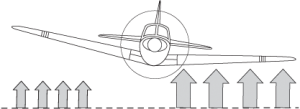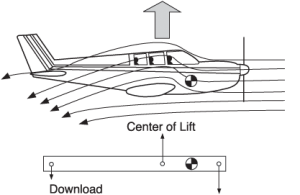This week, we’ll take a look at another aerodynamics topic: stability. Bob Gardner has this introduction in his textbook The Complete Private Pilot.
The three axes of control pass through the center of gravity. How the designer has related the centers of lift or pressure to the center of gravity affects the stability of the airplane. An inherently stable air-plane requires little effort to control, but is slow to react to maneuvering forces; as stability is decreased, it will react more quickly but require constant attention. Aerobatic airplanes and airliners represent the extremes of stability.
Your airplane is designed to be stable around the yaw (vertical) axis by placing the tail surfaces away from the center of gravity. If you are in straight and level flight and depress the right rudder pedal, the nose will swing to the right, but will return very quickly to the original position when pressure is released. This is called “streamlining”—if no pressure is exerted on a control surface it will align itself with the airstream. (Do this experiment without passengers on board; it’s unsettling for those in the back seat!)
Stability around the longitudinal axis is provided by dihedral, the upward slant of the wings from their roots to the wing tips (Figure 1). If the airplane is disturbed from straight-and-level flight by a wing being lowered, the descending wing will be at a greater angle of attack than the rising wing. The resulting increase in lift on the lowered wing will result in the wings leveling themselves. This built-in leveling effect makes small bank angles more difficult to sustain than larger bank angles. Almost all airplanes have good short-term lateral stability but poor long-term lateral stability: in the absence of an autopilot, don’t expect hands-off, wings-level flight for long periods of time.
Stability around the lateral (pitch) axis is determined by the relationship between the center of gravity and the position of the center of lift, which moves as the downward force on the horizontal stabilizer changes (Figure 2). If you disturb the airplane from straight-and-level flight by pulling back slightly on the control yoke and then releasing it, the airplane will climb briefly until airflow over the horizontal stabilizer diminishes, and then the reduced download on the stabilizer will allow the nose to drop below the horizon. The airspeed will then increase (momentarily) and the increasing download on the horizontal stabilizer created by the added airflow will raise the nose above the horizon. These oscillations will gradually diminish in amplitude until the airplane regains level flight.
The designer provides this stability when establishing the permissible limits of center of gravity movement. For every pitch attitude there is a power setting that creates just enough download on the horizontal stabilizer for the airplane to maintain level flight; an increase in power will cause the nose to pitch up, the speed to decrease, and the airplane to climb, and a reduction in power will have the opposite effect. Airplanes with the horizontal stabilizer mounted high on the vertical fin (T-tails) get little or no control effect from power changes because the control surface is above the propeller’s discharge air (propwash). T-tailed airplanes (and all jets) must derive pitch control force solely from the relative wind.
Check back on Thursday for a post from our CFI discussing how you might see this subject appear on an FAA exam.






